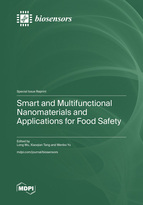Smart and Multifunctional Nanomaterials and Applications for Food Safety
A special issue of Biosensors (ISSN 2079-6374). This special issue belongs to the section "Biosensor Materials".
Deadline for manuscript submissions: closed (20 July 2023) | Viewed by 32920
Special Issue Editors
Interests: biosensors; functional nanomaterials; food safety; anlytical techniques; food analysis
Special Issues, Collections and Topics in MDPI journals
Interests: nanobodies; mycotoxins; rapid detection
Special Issues, Collections and Topics in MDPI journals
Special Issue Information
Dear Colleagues,
Nanostructured materials have been developed in the last few decades. The unique properties of these materials, such as quantum size and high surface-to-volume ratio effects, make them attractive and powerful objects for fundamental research and potential new directions. Nanomaterials allow the measurement and monitoring of harmful substances and a variety of biological signals by various techniques, which can further allow practical applications in analytical science related to biology, biomedicine, chemistry, the environment, and food, etc.
The common types of smart and multifunctional nanomaterials used in sensors and analytical techniques are microfluidic assay devices (µFADs), micro-electromechanical systems (MEMS), optical sensors, electrodes, force or pressure sensors, stretch sensors, temperature sensors, magnetic relaxing sensors, etc.
These nanomaterials can help improve the performance and broaden the applications of analytical techniques in assuring the safety and quality of food and pharmaceuticals, developing new methodology approaches, facilitating physicians to diagnose diseases, supporting the legal process, as well as providing measurements and directions to trade and commerce. We aim to construct a research platform to bridge materialogy with analytical science and other regulations.
This research topic covers papers related to the development and use of smart and multifunctional nanomaterials related to their applications in food safety and control. We accept original, technical, or review papers on (but not limited to) the following topics:
- Novel nanomaterials for analytical concepts, mechanisms and detection principles;
- Development of nanomaterial-based chemical sensors and biosensors, including electrochemical, optical, thermometric, magnetic transducer or transducing microsystems;
- Advances in fabrication technologies for chemical sensors, biosensors, chip-based detection devices;
- Nanomaterial-based analytical techniques in chemistry, biology, food science, environment, etc.
Dr. Long Wu
Dr. Xiaoqian Tang
Dr. Wenbo Yu
Guest Editors
Manuscript Submission Information
Manuscripts should be submitted online at www.mdpi.com by registering and logging in to this website. Once you are registered, click here to go to the submission form. Manuscripts can be submitted until the deadline. All submissions that pass pre-check are peer-reviewed. Accepted papers will be published continuously in the journal (as soon as accepted) and will be listed together on the special issue website. Research articles, review articles as well as short communications are invited. For planned papers, a title and short abstract (about 100 words) can be sent to the Editorial Office for announcement on this website.
Submitted manuscripts should not have been published previously, nor be under consideration for publication elsewhere (except conference proceedings papers). All manuscripts are thoroughly refereed through a single-blind peer-review process. A guide for authors and other relevant information for submission of manuscripts is available on the Instructions for Authors page. Biosensors is an international peer-reviewed open access monthly journal published by MDPI.
Please visit the Instructions for Authors page before submitting a manuscript. The Article Processing Charge (APC) for publication in this open access journal is 2700 CHF (Swiss Francs). Submitted papers should be well formatted and use good English. Authors may use MDPI's English editing service prior to publication or during author revisions.
Keywords
- microfluidic assay devices (µFADs)
- electrochemical sensors
- contaminant analysis
- magnetic relaxing sensors
- optical sensors (SERS, fluorescence, etc.)
- sensing materials
- nanozymes
- food safety
- environmental monitoring
- food analysis









